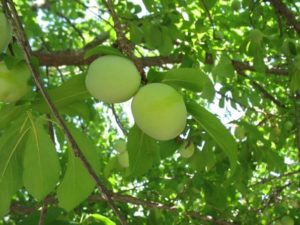
My mother’s visiting from San Francisco this week, and we celebrated Mother’s Day and the abundance of spring by bottling up six quarts of Japanese plum wine. When I posted a photo of the finished product online, several people asked for the recipe. So here it is, for all to enjoy.
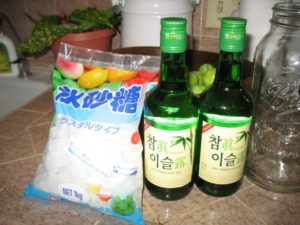
Japanese plum wine (umeshu in Japanese) isn’t really wine. It’s sweetened plum-flavored liqueur. If you have an over-productive plum tree (as we do), this is a great way to thin the tree and make something useful from the thinnings. And if you endure hot summers (as we do), there’s nothing better than ice-cold plum wine to greet a warm evening.
INGREDIENTS (makes 2 qts)
- 30-40 unblemished green (unripe) plums
- 1 kilogram rock crystal sugar (kōrizato in Japanese; you may only need 2/3 kg, but it usually comes in one-kilo bags)
- one 750-ml bottle of neutral spirits (preferably Japanese shōchū, but any neutral spirit will work, like vodka)
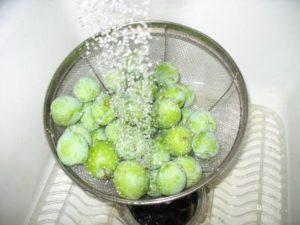
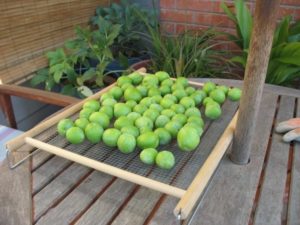
Sort through your plums and discard any that are blemished or broken. Pull off stems and leaves. Wash under running water, then let dry. I usually lay them out on a drying rack or a cloth-covered tray, then set in a warm, shady place to dry.
Meanwhile, gather and wash the jars you’re going to use. I’ve used pint jars, quart-sized jars, and half-gallon Mason jars, but find the quart-sized ones work best. They just fit more easily in the fridge once opened. This time round, since I was using so many jars and most of them had been previously used and were a bit dusty, I ran them through the dishwasher. But I don’t generally bother sterilizing them, given the high alcohol content. (For lids I just use plastic lids or a used, clean set of bands and seals.)
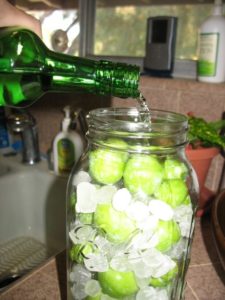 Bring the dry fruit inside, then start assembling your jars of plum wine. This part’s fun and easy. You just alternate layers of plums and sugar. I start with a layer of plums (four to six, depending on their size & the size of the jar), cover with a layer of sugar, then plums, then sugar, up to the top of the jar. Then pour the spirits over till you’ve covered everything. If you have a plum sticking out over the liquid at the top, take it out. Everything should be covered. (For a quart-sized jar, I need 16-18 plums & about 1/3 kg of sugar.)
Bring the dry fruit inside, then start assembling your jars of plum wine. This part’s fun and easy. You just alternate layers of plums and sugar. I start with a layer of plums (four to six, depending on their size & the size of the jar), cover with a layer of sugar, then plums, then sugar, up to the top of the jar. Then pour the spirits over till you’ve covered everything. If you have a plum sticking out over the liquid at the top, take it out. Everything should be covered. (For a quart-sized jar, I need 16-18 plums & about 1/3 kg of sugar.)
Now seal up your jars and label them. I always write the year and what kind of liqueur I’ve used. It’s definitely worth experimenting. Experiments that have worked for us: Vodka. Korean soju (usually cheaper than shōchū but pre-sweetened with corn syrup, so not my first choice). Experiments that did NOT work: Gin (yuck). Turbinado sugar instead of rock crystal sugar (gross). I’ve never tried it with other varieties of fruit, like pluots, but it’d be worth a try.

Store your jars in a cool, dry place like a wine cellar, if you’re lucky enough to have one. We store all our jarred stuff in the bottom of a linen closet. When the Apocalypse comes, we’ll be drinking plum wine and eating homemade jam till the end of the world.
Apparently you can start drinking umeshu within three to six months, but I’ve always waited till the following summer, when the rising temperatures remind me of the pleasures of chilled plum wine. The sugar will dissolve, the plums will darken, and the liqueur take on an amber color.
 This stuff keeps for a long time in storage. It’s 2013, and we’re just now finishing our 2009 batch. Once we open a jar, we do keep it in the fridge. It keeps for a long time there too.
This stuff keeps for a long time in storage. It’s 2013, and we’re just now finishing our 2009 batch. Once we open a jar, we do keep it in the fridge. It keeps for a long time there too.
Umeshu is strong stuff (most shōchū are 24% alcohol), so a little goes a long way. I like it best splashed over ice and diluted with some water. Kampai!
(Note: All photos from 2009. My letting-it-go-gray hair does not look like this today!)
Where do you get the plums from?
Hi, Madeline. I have my own plum tree, so make the wine with green plums I pick in April or May. But when I lived in SF (and didn’t have my own plum tree), I’d see green plums for sale in Japanese grocery stores. If there are any Japanese (or even more generally Asian) food stores near you, they might stock them.
Hi. Thank you for your reply. Is it possible to make umeshu with ripe plums instead of green plums?
You’re welcome. I’ve never tried it with ripe plums, and while I know nothing of the chemistry, I personally wouldn’t recommend trying this with ripe fruit. I think the plums would simply collapse in the alcohol & you’d get a pulpy mess. Whether or not that mess would be tasty anyway I couldn’t say. And I’m not sure if there would be safety concerns too with using ripe fruit. Our ripe fruit we consume raw, give away, or turn into jams, jellies, cobblers, ice creams, etc.
Thank you Naomi!
Hello Naomi, thanks for your information. We have put together 12 quart jars and today when I peeked at them in the bottom of my linen closet, I find that several of the lids (I used standard canning lids and rings) have expanded and “crinkled.” Have you ever had that happen and should i be concerned?
Hi, Mary Lynn. You’re not the first commenter to note this issue. I have to confess we’ve never had this happen, but as one commenter above noted, it seems like it’s not uncommon for there to be a build-up of gases in the jars, and some folks apparently “burp” their jars once or twice early on to release that gas. You might see if that works for you. I’m not a food-safety expert, so I can’t speak to whether or not you should be concerned. Like I said, I’ve just never had this happen. And we certainly have never had a batch go “bad.” But you should of course follow your own instincts about that, and perhaps do some research on your own. Thanks for reading!
Hi there I cannot wait to try this recipe, I was wondering if u know of any plum wine recipes that are sweet and with a spice background
Hi, Tami – Thanks for reading. The recipe I use is already very sweet. I’ve never tried it with any spices or herbs & I haven’t seen any recipes to that effect. But the Internet’s a big place — no doubt someone has tried it & posted about it!
Can you use ripe plums on your Japanese plum wine recipe?
Hi, Leiko. I’ve never tried using ripe plums. I’m not sure ripe plums would hold their shape stewing in the alcohol. You might end up with a mess of burst fruit. But I’m just speculating here.
When it is ready to drink, do you do anything, like strain it, etc.?
Hi, and thanks for reading! I don’t strain it, but I do dilute it with both water & ice. Some people eat the plums, I’m told. But the hard, wrinkly fruit doesn’t quite appeal to me.
Come on over, Saved-by-the-Bay! Plenty for everyone. 🙂 Thanks for reading & sharing.
This is a fantastic post. I’m going to share it with plum-tree-caretakers and connoisseurs of Japanese food & drink everywhere. Love this line: “When the Apocalypse comes, we’ll be drinking plum wine and eating homemade jam till the end of the world.” And can I join you when that happens?
Hi Naomi,
Using a plastic lid for a pint size wide-mouth jar is not a good idea. It leaked a little as I drove back home and in the process of cleaning the outside of jars, labels came off (it comes off easily as you hoped for the future use). I replaced them with a regular canning cap and disc.
Okasan
Oh, darn! Sorry you had to deal with that. Well, good to know.
Hello, just found your post because I was searching rock sugar and umeshu. Perfect timing. Thanks for the info. My mother gave me several pounds of ume on Mother’s Day. I am making umeboshi and umeshu for the first time.
So glad you found my post! This is exactly why I put it up, figuring someone out there might be in need of a recipe or in possession of extra ume. I’ve never tried umeboshi — a bit intimidated by the process. Good luck, and thanks for reading!
One more question – I read on another website that you shouldn’t fill the jars all the way up (only halfway) because the plums exude juice that will cause the jars to overflow. That doesn’t really make sense to me but I thought I would ask your opinion since you have already done this process many times. Do you fill your jars all the way to the top? I only left about 1/4-1/2 in headspace and am wondering if I should drain some off…
Hmm. I’ve never noticed any increase in volume. I guess I leave a little bit of headspace — 1/2 inch? Maybe an inch? Honestly, I’m not that careful about it. But my experience with this suggests that if you fill up the jars only halfway, you’ll end up with half-full jars of umeshu. This idea that the plums exude liquid & fill up the empty space in the jars: that would seem to defy the laws of physics. 🙂
Thanks, Naomi. I thought it wasn’t possible, that’s why I was confused. Last question…I hope… Is it supposed to bubble? One of my canning lids dinged yesterday. I opened it this morn and it was definitely pressurized. It looks like the fruit is possibly fermenting. Should it? My husband made mead last month and I know he had to constantly open the jars to reduce the pressure. It doesn’t sound like you do anything other than jar it and let it sit. I’m hoping I didn’t mess this up. Thanks for sharing your knowledge and your patience.
Hi, Denise. I just examined the 4 quarts of umeshu I put up last week, and yes, there’s some minor bubbling action going on in there. When I press on the lids (I used canning seals & bands), there does seem to be some pressure there. I don’t know the chemical ins & outs of fermentation, but certainly the plums get sort of pickled by the alcohol. By next spring–or even earlier–they’ll look sort of brownish & puckered (not very beautiful). I don’t think your umeshu will be hurt by your having opened the jars. It’s not like jam in that way. I’m also thinking maybe this is why some people recommend leaving more space at the top of the jar — to provide space for gases produced by the breakdown of the sugar & whatever happens with the fruit? I’ve made umeshu 4 or 5 times now & have never had a jar break. I certainly hope this isn’t the year that happens!
Oh, but here’s a person who recommends turning the jars upside-down briefly for the first couple of days & also “burps” the jars by opening them a little to let the gases out: http://jonsinger.livejournal.com/61204.html?thread=1100564. I’ve never done either of these things, but couldn’t hurt.
Just wanted to come back and say thanks for your help. My umeshu looks like it’s coming along nicely. I referenced your blog in my blog post about my experience making umeshu. I hope that’s okay. I also have a post about umeboshi in case you decide to try that. You are right. It is much more difficult to make than the umeshu. Thanks again!
You’re so welcome, and thanks for the mention at your blog. Of course I don’t mind! 🙂
Hey, Naomi. Years ago, I used to make Japanese Plum Wine Jelly. Let me know if you would like the recipe. It puts a new spin on PB&J for sure. Susan
Hi, Susan. I would LOVE that recipe!
Japanese Plum Wine Jelly
(Makes 3 1/2 cups, enough to fill 5-6 small jelly jars or glasses)
Ingredients:
1 3/4 cups Japanese plum wine
1/4 cup lemon juice, strained
3 cups sugar
1/2 bottle (6-ounce size) pectin
Also need canning paraphernalia, including parafin, jars and lids
Sterilize 5 or 6 jelly jars or glasses and lids. Leave in hot water until ready to fill.
Mix wine, lemon juice and sugar in top of double boiler. Place over boiling water, heat, stirring to dissolve sugar.
Remove from heat as soon as sugar is dissolved. Stir in liquid pectin.
Remove jars from hot water, using tongs. Pour jelly into hot, sterilized jelly jars. Cover each with 1/8 inch melted paraffin. Cover with lids.
–Susan
Can’t wait to make this. Thanks!
Thanks for doing all this! It’s delicious. 🙂